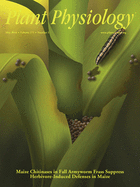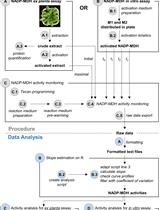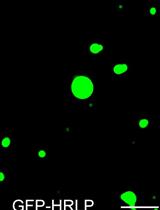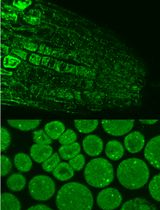- EN - English
- CN - 中文
Measurement of ATP Hydrolytic Activity of Plasma Membrane H+-ATPase from Arabidopsis thaliana Leaves
拟南芥叶片质膜上H+-ATP酶的ATP水解活性测定
发布: 2016年12月05日第6卷第23期 DOI: 10.21769/BioProtoc.2044 浏览次数: 9876
评审: Dennis NürnbergAnonymous reviewer(s)
Abstract
Plant plasma membrane H+-ATPase, which is a P-type ATPase, couples ATP hydrolysis to H+ extrusion and thereby generates an electrochemical gradient across the plasma membrane. The proton gradient is necessary for secondary transport, cell elongation, and membrane potential maintenance. Here we describe a protocol for measurement of the ATP hydrolytic activity of the plasma membrane H+-ATPase from Arabidopsis thaliana leaves.
Keywords: Arabidopsis thaliana (拟南芥)Background
Determination of the plasma membrane H+-ATPase activity is important to elucidate its function and regulatory mechanism. However, it is sometimes difficult to determine the ATP hydrolytic activity of the plasma membrane H+-ATPase, because plant cells contain many ATP hydrolytic enzymes. This protocol is developed based on the publications by Uemura and Yoshida (1986) and Kinoshita et al. (1995). We used KNO3 as an inhibitor of V-type ATPases, ammonium molybdate as an inhibitor of acid phosphatases, oligomycin as an inhibitor of F-type ATPases, and NaF as an inhibitor of phosphatases (Shimazaki and Kondo,1987; Kinoshita et al.,1995). Orthovanadate inhibits the P-type ATPase and thus can be used to measure the activity of the plasma membrane H+-ATPase by assessing the vanadate-sensitive Pi release from ATP hydrolysis. The released Pi reacts with molybdate to form a blue complex which can then be quantified by measuring absorption at 750 nm.
Materials and Reagents
- Ultracentrifuge tube (Beckman Coulter, catalog number: 349623 )
- Cuvette (100 µl) (Beckman Coulter, catalog number: 523270 )
Note: This product has been discontinued. - Arabidopsis thaliana ecotype Col-0
- Dithiothreitol (DTT) (NACALAI TESQUE, catalog number: 14128-04 )
- Phenylmethylsulfonyl fluoride (PMSF) (NACALAI TESQUE, catalog number: 273-27 )
- Leupeptin (Wako Pure Chemical Industries, catalog number: 126-03754 )
- MOPS (NACALAI TESQUE, catalog number: 23415-54 )
- Oligomycin (Sigma-Aldrich, catalog number: 75351 )
- Sodium chloride (NaCl) (Wako Pure Chemical Industries, catalog number: 191-01665 )
- Ethylenediamine-N,N,N’,N’-tetraacetic acid (EDTA) (Dojindo Molecular Technologies, catalog number: N001-10 )
- Sodium fluoride (NaF) (NACALAI TESQUE, catalog number: 31420-82 )
- Tris (NACALAI TESQUE, catalog number: 35406-91 )
- 2-(N-morpholino)ethanesulfonic acid (MES) (NACALAI TESQUE, catalog number: 21623-26 )
- Magnesium sulfate (MgSO4) (Wako Pure Chemical Industries, catalog number: 131-00405 )
- Potassium chloride (KCl) (Wako Pure Chemical Industries, catalog number: 163-03545 )
- Potassium nitrate (KNO3) (Wako Pure Chemical Industries, catalog number: 160-04035 )
- Ammonium molybdate (Wako Pure Chemical Industries, catalog number: 016-06902 )
- Triton X-100 (Wako Pure Chemical Industries, catalog number: 169-21105 )
- ATP (NACALAI TESQUE, catalog number: 10406-61 )
- Sodium orthovanadate (Sigma-Aldrich, catalog number: S6508 )
- SDS (NACALAI TESQUE, catalog number: 31607-65 )
- Sodium molybdate (Wako Pure Chemical Industries, catalog number: 196-02472 )
- Sulfuric acid (H2SO4) (Wako Pure Chemical Industries, catalog number: 192-04696 )
- 1-amino-2-naphthol-4-sulfonic acid (ANSA) (NACALAI TESQUE, catalog number: 02212-12 )
- Sodium bisulfite (NaHSO3) (Wako Pure Chemical Industries, catalog number: 190-01375 )
- Sodium sulfate (Na2SO4) (Wako Pure Chemical Industries, catalog number: 192-03415 )
- Potassium dihydrogen phosphate (KH2PO4) (Wako Pure Chemical Industries, catalog number: 169-04245 )
- DTT stock solution (see Recipes)
- Protease inhibitor solution (see Recipes)
- Oligomycin solution (see Recipes)
- Homogenization buffer (see Recipes)
- 2x ATPase buffer (see Recipes)
- ATPase reaction buffer (see Recipes)
- ATP solution (see Recipes)
- Vanadate solution (see Recipes)
- Stop solution (see Recipes)
- ANSA solution (see Recipes)
- Pi standard stock solution (see Recipes)
Equipment
- Mortar (90 mm diameter) and pestle
- Refrigerated centrifuge (TOMY DIGITAL BIOLOGY, model: MX-307 )
- Ultracentrifuge (Beckman Coulter, model: OptimaTM TLX )
- Vortex (Scientific Industry, model: SI-0286 )
- Heat block (TAITEC, model: e-ThermoBucket ETB )
- Spectrophotometer (Beckman Coulter, model: DU 730 )
Note: This product has been discontinued.
Procedure
文章信息
版权信息
© 2016 The Authors; exclusive licensee Bio-protocol LLC.
如何引用
Readers should cite both the Bio-protocol article and the original research article where this protocol was used:
- Okumura, M. and Kinoshita, T. (2016). Measurement of ATP Hydrolytic Activity of Plasma Membrane H+-ATPase from Arabidopsis thaliana Leaves. Bio-protocol 6(23): e2044. DOI: 10.21769/BioProtoc.2044.
- Kinoshita, T., Nishimura, M. and Shimazaki, K. (1995). Cytosolic concentration of Ca2+ regulates the plasma membrane H+-ATPase in guard cells of fava bean. Plant Cell 7(8): 1333-1342.
分类
植物科学 > 植物生理学 > 离子分析
植物科学 > 植物生物化学 > 蛋白质 > 活性
生物化学 > 蛋白质 > 活性
您对这篇实验方法有问题吗?
在此处发布您的问题,我们将邀请本文作者来回答。同时,我们会将您的问题发布到Bio-protocol Exchange,以便寻求社区成员的帮助。
Share
Bluesky
X
Copy link













